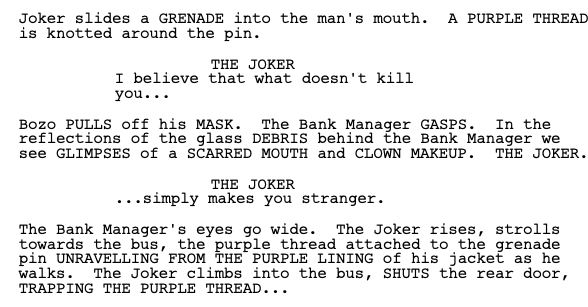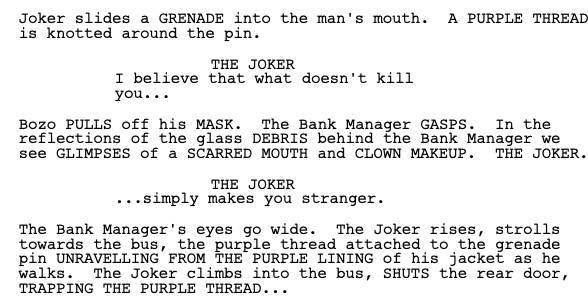What is screenwriting character introduction? They say you only get one chance to make a first impression, and in the world of screenwriting, that couldn’t be more true. Crafting a memorable character introduction is an art that goes beyond mere words on a page. In this blog post, we’ll explore how to write effective character introductions—going beyond the basics to keep your audience glued to the screen, supplemented by illustrative examples. Ready to breathe life into your characters? Let’s dive in!
Table of Contents

What Is Screenwriting Character Introduction?
Screenwriting character introduction refers to the process of introducing a character in a screenplay or script. It’s a crucial element in storytelling as it sets the stage for how the audience perceives and connects with the character. A well-crafted character introduction can capture the audience’s attention, create intrigue, and establish a foundation for the character’s journey throughout the story.
The whole point is to make the character stick in the audience’s mind and make them want to keep watching.
How To Write Screenwriting Character Introduction That Makes A Lasting Impression
Here’s a guide on how to write a screenwriting character introduction that makes a lasting impression:
Know Your Character Inside Out
Before putting pen to paper (or fingers to keyboard), take the time to fully understand your character. What are their quirks, motivations, fears, and goals? The more you know, the more authentic and engaging your introduction will be.
Identify Key Traits
Choose a few key traits that define your character and aim to highlight them in the introduction. Whether it’s a unique skill, a defining flaw, or a particular mannerism, these traits will help your character stand out.

Choose the Right Moment
Don’t introduce your character arbitrarily. Consider the story’s pacing and choose a moment that maximizes their impact. Is it in the midst of chaos, revealing their hidden strength? Or in a quiet scene, showcasing their vulnerability? Finding the perfect entry point builds tension and raises questions about their role.
Create Visual Impact
Use vivid and metaphorical examples to paint a clear picture of your character. Readers should be able to visualize the character in their minds. Think about appearance, clothing, and any distinctive features that set them apart.
Introduce Through Action
Instead of merely describing your character, consider introducing them through action. Show them doing something that immediately captures attention or reflects a core aspect of their personality. Use hyperbole examples sentences to exaggerate certain traits for dramatic effect.
Distinctive Dialogue
Craft dialogue that is true to your character’s voice. Whether it’s a unique turn of phrase, a specific way of speaking, or a memorable catchphrase, dialogue can reveal a lot about a character in a short amount of time. Considering assonance examples to create a pleasant and rhythmic quality in their speech.
Balance Information
While it’s important to provide enough information to establish the character, avoid overwhelming the audience with details. Gradually reveal more about the character as the story unfolds.

Embrace Contrast
Introduce your character against a backdrop that highlights their unique qualities. A seasoned detective amidst a crime scene, a shy artist in a bustling club, a stoic warrior facing unexpected tenderness – these contrasts make your character stand out and pique the audience’s interest.
Drop a Hint of Mystery
Don’t reveal everything about your character in their first scene. Leave some room for intrigue. Plant a seed of mystery, a hidden goal, or a past trauma that hints at their complexity. This keeps the audience engaged and eager to learn more. Or engaging your audience’s curiosity with strategic repetition examples.
Test Your Introduction
Once you’ve written the introduction, get feedback. Share it with others and see if it achieves the desired impact. Adjustments may be necessary based on different perspectives.
Remember, the goal is to make your audience care about your character from the moment they are introduced. By combining careful consideration of Screenwriting Character Introduction, engaging descriptions, and thoughtful actions, you can craft a screenwriting character introduction that leaves a lasting impression.
Examples Of Screenwriting Character Introduction
Indiana Jones in “Raiders of the Lost Ark” (1981)
Indy appears in the dense jungle, facing traps and adversaries to obtain an artifact. This sets the tone for his adventurous, risk-taking personality.
Hannibal Lecter in “The Silence of the Lambs” (1991)
Lecter is introduced in his prison cell, calm and composed, yet exuding an eerie intelligence. The atmosphere and dialogue immediately establish his menacing presence.

Jack Dawson in “Titanic” (1997)
Jack wins a third-class ticket in a poker game and arrives at the grand ship with wide-eyed wonder, showcasing his free-spirited and optimistic nature.

The Wicked Witch of the West in “The Wizard of Oz” (1939)
The Wicked Witch’s arrival is marked by dark clouds, ominous music, and her cackling, establishing her as the primary antagonist with a malevolent presence.
Tyler Durden in “Fight Club” (1999)
Tyler is introduced through his chaotic and rebellious actions, setting the stage for the anarchic philosophy that defines his character.
Forrest Gump in “Forrest Gump” (1994)
Forrest sits at a bus stop, narrating his life story to strangers. This unique approach immediately captivates the audience and introduces Forrest’s simplicity and innocence.
Joker in “The Dark Knight” (2008)
Introduction: The Joker’s chaotic bank robbery establishes his unpredictability and nihilistic worldview, leaving a lasting impact on the audience.

Conclusion
Crafting a compelling screenwriting character introduction is like painting the first strokes of a captivating story. Whether through action, distinctive dialogue, or visual impact, the goal is to engage viewers from the start and make them eager to discover more about the characters as the story unfolds.
Ref: So Create | Write and Co


